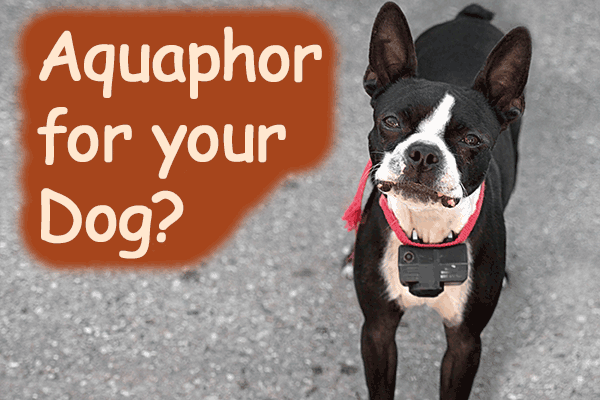At DoggiPro, we understand how much you love your furry friends. As dedicated dog owners ourselves, we know your pup’s health and well-being are top priorities. One question we often get asked is, “Is Aquaphor safe for dogs?” The short answer is yes. Aquaphor is generally safe for dogs when used correctly and in moderation. When used as directed, Aquaphor can be a safe and effective part of your dog’s skincare routine. However, there is more to that than a simple yes or no.
You might have heard about Aquaphor and how it is a popular skincare product for humans, and you’ve wondered if it’s okay to use on your canine companion. Well, you’ve come to the right place! We’ll dive deep into the world of Aquaphor and its potential benefits for your dog’s skin. We’ll explore what makes Aquaphor a popular choice, how to use it safely, and what precautions to take.
We’ll also answer those burning questions like, “Is Aquaphor toxic if ingested?” and “Is Aquaphor or Vaseline better for dogs?” So, please grab a cup of coffee and settle in as we embark on this journey to uncover the truth about Aquaphor for dogs. By the end of this ultimate guide, you will have the knowledge you need to make informed decisions about your pup’s skincare routine.
Understanding Aquaphor and Its Uses for Dogs
Let’s start by getting to know Aquaphor better. At its core, Aquaphor is a multi-purpose ointment designed to soothe and protect skin. The Aquaphor ingredients include petrolatum, mineral oil, lanolin, glycerin, panthenol, and bisabolol. While it might not sound exciting, this combination creates a powerful barrier that locks in moisture and promotes healing. It’s like a warm hug for your dog’s dry, irritated skin!
But why is this important for our canine companions? You see, just like us, dogs can experience various skin issues. Their skin can become dry, itchy, or even cracked due to weather changes, allergies, or underlying conditions. This situation is where Aquaphor comes in. Its rich, emollient formula helps hydrate and soothe dry skin, relieving discomfort and promoting healing.
Consider Aquaphor as a versatile tool in your dog’s skincare arsenal. It’s not just for humans – it can also be a lifesaver for your furry friend! Whether your pup has a dry nose, cracked paw pads, or minor scrapes, Aquaphor can help protect and heal their delicate skin. This versatility empowers you as a dog owner, giving you a resource to address a variety of skincare issues and making you feel more prepared to handle any situation.
But before you grab that tube of Aquaphor and apply it to your dog, it’s crucial to understand how to use it safely and effectively. We’ll discuss that in the next section. Responsible pet ownership means staying informed and making well-considered choices for your dog’s well-being. We respect your dedication to your furry friend, and we’re here to help you make informed decisions about their skincare.
Common Skin Issues in Dogs and How Aquaphor Helps
As dog lovers, we know that our furry friends can experience a variety of skin woes, just like us humans. From itchy patches to dry noses and cracked paws, these issues can cause discomfort and affect their quality of life. Fortunately, Aquaphor can often come to the rescue, providing relief and promoting healing.
The ointment’s soothing properties can work wonders if your pup suffers from itchy skin. The emollient formula helps to moisturize the skin, reducing dryness and irritation that can trigger itching. Aquaphor creates a protective barrier that shields the skin from further irritation, allowing it to heal naturally. This should reassure you of its effectiveness and give you confidence in its ability to provide relief.
Dry noses and cracked paw pads are common problems, especially during harsh weather conditions. Aquaphor can help moisturize and soften these areas, relieving dryness and further cracking. It acts as a protective layer, shielding the delicate skin from environmental irritants and allowing it to repair itself.
But that’s not all! Aquaphor can also soothe minor cuts and scrapes, helping to prevent infection and promote faster healing. Its gentle formula is safe for most dogs and can be applied directly to the affected area.
So, if your furry friend has dry, itchy, or irritated skin, don’t hesitate to reach for that trusty tube of Aquaphor. It’s a versatile and effective remedy that can provide much-needed relief and help your dog feel its best.
How to Safely Apply Aquaphor to Your Dog
Now that you know the amazing benefits of Aquaphor for your dog’s skin, let’s talk about how to use it safely and effectively. After all, we want to ensure our furry friends get the most out of this healing ointment.
- First, always start with clean paws (and skin!). Before applying Aquaphor, gently wash the affected area with a mild dog shampoo and pat it dry. Cleaning helps to remove any dirt or debris that could interfere with the ointment’s effectiveness.
- Next, take a small amount of Aquaphor and warm it up slightly between your fingers. This makes it easier to spread and more comfortable for your dog. Apply a thin layer to the affected area, gently massaging it in. Remember, a little goes a long way!
- The tricky part is preventing your dog from licking off the Aquaphor. We know how tempting it can be for them to indulge in a little taste test, but it’s important to discourage this behavior. You can use a few tricks to keep your pup from licking.
- Distract them with a favorite toy or treat while the Aquaphor absorbs. If your dog is particularly persistent, you can use an Elizabethan collar (a cone) or a bandana to block their access to the treated area. You can apply Aquaphor right before a walk or mealtime so they’re too preoccupied to lick.
Remember, consistency is key. Apply the Aquaphor as directed, usually 2-3 times a day, and monitor your dog’s skin for any signs of improvement or irritation. If you notice any adverse reactions, discontinue use and consult your veterinarian.
With a little patience and perseverance, you can help your furry friend reap the full benefits of Aquaphor and enjoy healthier, happier skin.
Is Aquaphor or Vaseline Better for Dogs?
You might be wondering, “Isn’t Vaseline similar to Aquaphor? Can’t I use that instead?” It’s a fair question! Aquaphor and Vaseline are petroleum jelly-based products, and they share similarities in their ability to create a protective barrier on the skin. However, some key differences exist regarding Aquaphor vs Vaseline for wound healing on your furry friend.
Aquaphor has a few advantages over Vaseline. It contains additional ingredients like panthenol and glycerin, which can help soothe and moisturize the skin. Panthenol is known for its healing properties, while glycerin attracts moisture to the skin, keeping it hydrated. Aquaphor is a better choice for dry, cracked skin or minor irritations.
On the other hand, Vaseline is a simpler product, consisting mainly of petroleum jelly. While it effectively creates a barrier to protect the skin, it doesn’t offer the same moisturizing and healing benefits as Aquaphor.
So, which one is better for your dog? It depends on the specific situation. In general, Aquaphor is better for minor cuts, scrapes, or dry skin due to its additional soothing and moisturizing ingredients. However, if you’re looking for a barrier to protect your dog’s paws from harsh weather conditions, Vaseline can do the job just fine.
Ultimately, the best way to determine which product is right for your dog is to consult your veterinarian. They can assess your dog’s needs and recommend the most appropriate treatment.

Specialized Uses of Aquaphor for Dogs
You might be surprised to learn that Aquaphor has a variety of specialized uses for your furry friends beyond just moisturizing dry skin. Let’s explore some of these unique applications:
Can I Put Aquaphor on My Dog’s Chapped Lips?
Absolutely! Dogs, like humans, can experience chapped lips due to dry weather or excessive licking. A small amount of Aquaphor can provide much-needed relief and help their lips heal faster. Just apply it sparingly and prevent your dog from licking it off immediately.
Aquaphor for Minor Burns and Pressure Sores
If your dog has suffered a minor burn or developed pressure sores (often seen in older dogs who lie in the same position for long periods), Aquaphor can be a lifesaver. Its soothing and protective properties can help alleviate discomfort, promote healing, and prevent infection. However, please consult your veterinarian for severe burns or pressure sores, which may require additional treatment.
Aquaphor for Paw Pad Hyperkeratosis
This condition, characterized by thickened and hardened paw pads, can be uncomfortable for your dog. Aquaphor can help soften the paw pads and reduce calluses, making walking more comfortable. However, addressing the underlying cause of hyperkeratosis with your vet’s guidance is important.
Aquaphor for Post-Surgical Incisions
After surgery, your vet may recommend using Aquaphor to keep the incision site moisturized and protected. This moisturization can help reduce itching and prevent your dog from licking or scratching the area, which could disrupt the healing process.
Remember, while Aquaphor is a versatile and helpful tool, it’s not a substitute for professional veterinary care. Always consult your vet before using Aquaphor for serious skin conditions or injuries.
Precautions and When to Consult a Vet
While Aquaphor is generally safe for dogs, it’s important to be aware of potential risks and know when to seek professional help. Here are some precautions to keep in mind:
- Allergic Reactions: Although rare, some dogs may be allergic to Aquaphor or its ingredients. If you notice any signs of skin irritation, redness, swelling, or excessive itching after applying Aquaphor, discontinue use immediately and contact your veterinarian.
- Excessive Licking: As mentioned earlier, preventing your dog from licking the Aquaphor is crucial. Excessive ingestion can lead to gastrointestinal upset. If your dog can ingest a significant amount, monitor it closely and consult your vet if it shows any signs of illness.
- Open Wounds: Aquaphor is not suitable for deep wounds or punctures. It can trap bacteria and hinder healing. If your dog has an open wound, seek veterinary attention to ensure proper cleaning and treatment.
- Underlying Conditions: If your dog has persistent or severe skin issues, Aquaphor may provide temporary relief, but addressing the underlying cause is essential. Consult your vet for a proper diagnosis and treatment plan.
Remember, Aquaphor is a helpful tool but not a miracle cure. If you’re unsure about using Aquaphor or if your dog’s skin condition doesn’t improve, always avoid caution and seek professional advice. Your veterinarian can provide personalized guidance and ensure your furry friend receives the best care.
Frequently Asked Questions About Aquaphor for Dogs
As pet parents, it’s natural to have questions about new products we introduce to our furry friends. So, let’s address some of the most common concerns about Aquaphor for dogs:
Is Aquaphor Toxic if Ingested?
While Aquaphor is generally safe for external use, refrain from ingesting or eating it. The main ingredient, petrolatum, isn’t toxic, but consuming large amounts can cause an upset stomach or diarrhea. So, if your dog happens to lick a bit of aquaphor, don’t panic! Just monitor it for any signs of discomfort and contact your vet if you’re concerned.
Is It Okay If My Dog Licks Aquaphor?
As mentioned, a little lick won’t usually cause harm, but it’s best to discourage your dog from licking the applied area. Not only does it reduce the effectiveness of the treatment, but it can also lead to excessive grooming, which may further irritate your dog’s skin. Remember the tips we shared earlier for preventing licking!
Can I Use Aquaphor on Open Wounds?
Aquaphor is best suited for minor skin irritations, dry patches, and abrasions. It’s not recommended for deep wounds or punctures as it can trap bacteria and hinder healing. If your dog has an open wound, it’s always best to consult your veterinarian for proper treatment.
How Often Can I Apply Aquaphor to My Dog?
You can apply Aquaphor 2-3 times daily or as your vet directs. However, monitoring your dog’s skin and adjusting the frequency as needed is important. If you notice any irritation or the condition doesn’t improve, consult your vet.
We hope this FAQ section has answered some of your questions about Aquaphor for dogs. Remember, knowledge is power when caring for your furry companions.

Additional Home Remedies and Alternatives for Dog Skin Care
While Aquaphor is a fantastic option for many common dog skin issues, it’s not the only solution. At DoggiPro, we believe in a holistic approach to pet care, including exploring various options to find what works best for your dog.
So, let’s discuss some additional home remedies and pet-specific alternatives for dog skin care:
- Coconut Oil is a natural moisturizer favorite among many dog owners. It’s packed with fatty acids to help soothe dry, itchy skin and promote a healthy coat. You can apply a small amount topically or even add it to your dog’s food in moderation.
- Oatmeal Baths: If your dog suffers from widespread itchiness or skin irritation, an oatmeal bath can provide soothing relief. Colloidal oatmeal (finely ground oats) is particularly effective at calming irritated skin. Add it to lukewarm water and let your dog soak for a few minutes.
- Chamomile Tea: Chamomile has natural anti-inflammatory properties to help soothe skin irritation. Brew a strong cup of chamomile tea, let it cool completely, and then use it as a rinse or compress on affected areas.
- Apple Cider Vinegar: Use diluted apple cider vinegar as a topical rinse to help restore the skin’s pH balance and alleviate itching. However, be cautious if your dog has open wounds, as it can sting.
- Pet-Specific Balms and Ointments: Many commercially available balms and ointments are specifically formulated for dogs. These products often contain shea butter, beeswax, and essential oils that can nourish and protect your dog’s skin.
Remember, before trying any home remedy or new product, it’s always a good idea to consult your veterinarian. They can help you determine the best action for your dog’s needs and ensure the remedy is safe and appropriate.
At DoggiPro, we encourage you to explore options and find what works best for your furry friend. After all, a happy dog is a healthy dog!
Is Aquaphor Safe for Dogs? Verdict
As we wrap up this ultimate guide, we hope we’ve answered your question, “Is Aquaphor safe for dogs?” with a resounding YES! Aquaphor can be a valuable addition to your dog’s skincare routine, relieving common issues like dry skin, cracked paws, and minor irritations. Its unique blend of Aquaphor ingredients creates a protective barrier that locks in moisture and promotes healing, while its gentle formula makes it safe for most dogs.
Remember, while Aquaphor is generally safe, using it correctly and monitoring your dog for adverse reactions is crucial. If you have concerns or your dog’s skin condition doesn’t improve, always consult your veterinarian for personalized advice.
At DoggiPro, we’re committed to providing you with the most accurate and helpful information to ensure your furry friend’s well-being. We encourage you to share your experiences using Aquaphor on your dogs. Have you found it useful for any specific skin issues? Do you have any tips or tricks to share with fellow dog owners? We’d love to hear from you!
- Why Shih Tzu Are The Worst Dog: An In Depth Analysis - February 7, 2024
- Why Schnauzers Are The Worst Dogs (or Are They?) - February 7, 2024
- Can dogs eat gushers? The Answer Might Suprise You - January 26, 2024
